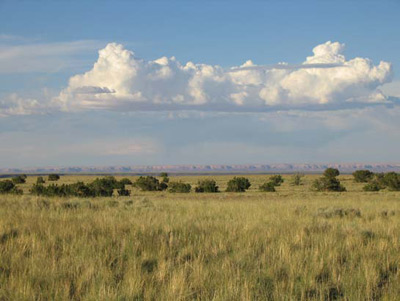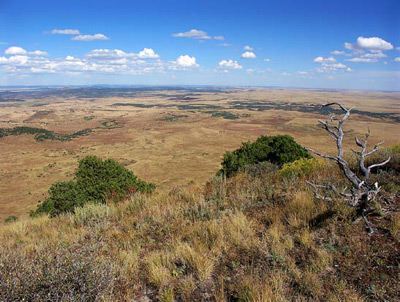Temperate grasslands like those of the American Southwest are characterized by seasonal temperature extremes, an annual dry season, and grass-dominated vegetative cover (Finch 2004, Ford et al. 2004).
Development, agriculture, and other land use practices have taken a heavy toll on temperate grasslands, fragmenting them into isolated islands and reducing their extent. Noss et al. (1995), who reviewed and summarized estimated habitat loss, degradation, and fragmentation in natural ecosystems across the United States, classified grasslands and shrublands as “critically endangered ecosystems”—ecosystems which have declined by more than 98%. Fire suppression and livestock grazing have also contributed to the decline of grasslands by facilitating further expansion of woody plants into former grasslands. The Nature Conservancy estimates that shrub encroachment has affected over 35,200 km2 (8.7 million acres) of grasslands nationwide (Gori and Enquist 2003).
Southwestern Grassland Types
In the American Southwest, grassland types vary based on topography, soil type and precipitation. This overview considers three general grassland types: Desert grasslands and shrub-steppe, Colorado Plateau semi-desert grasslands and shrub-steppe, and Southern Plains grasslands. Because the grasslands west of the Great Plains prairies typically include a significant shrub component, this overview covers both grasslands, which are dominated by perennial grasses, and shrub-steppe communities, which are dominated by both shrubs and perennial grasses.

NPS
Desert grasslands and shrub-steppe
Desert grasslands and shrub-steppe include low elevation grass and shrub communities adjacent to the Chihuahuan, Mohave, and Sonoran deserts (Robbie 2004). Common grass species include black grama (Bouteloua eriopoda), tobosa (Pleuraphis mutica), and curly mesquite (Hilaria belangeri). Prevalent shrub species include creosote bush (Larrea tridentata), velvet mesquite (Prosopis velutina), western honey mesquite (Prosopis glandulosa var. torreyana), tarbush (Flourensia cernua), turpentine bush (Ericameria larcifolia), desert ceanothus (Ceanothus greggii), and soaptree yucca (Yucca elata).

NPS
Colorado Plateau semi-desert grasslands and shrub-steppe
Colorado Plateau semi-desert grasslands and shrub-steppe occur in northern Arizona above the Mogollon Rim and in northern New Mexico (Robbie 2004), as well as in southern Utah and southwestern Colorado. These systems are found on nearly level landforms of sedimentary and igneous origin. Characteristic grass species include blue grama (Bouteloua gracilis), galleta (Pleuraphis jamesii), western wheatgrass (Pascopyrum smithii), needle and thread (Hesperostipa neomexicana), and several species of three-awn (Aristida spp.). Common shrubs include big sagebrush (Artemesia tridentata), black sagebrush (Artemesia nova), four-wing saltbush (Atriplex canescens), rabbitbrush (Ericameria nauseosa), broom snakeweed (Gutierrezia sarothrae), and several species of joint-fir (Ephedra spp.).

© Tobias Hasse
Southern Plains grasslands
Southern Plains grasslands consist of shortgrass and midgrass prairies occurring within semi-arid to subhumid climates (Robbie 2004). In contrast to semi-desert and Colorado Plateau grasslands, which include a significant shrub component, the prairies of the southern plains are dominated by grasses. Characteristic shortgrass prairie species include blue grama (Bouteloua gracilis), buffalo grass (Buchloe dactyloides), and western wheatgrass (Pascopyrum smithii). Little bluestem (Schizachyrium scoparium), sideoats grama (Bouteloua curipendula), and Indiangrass (Sorghastrum nutans) are typical of midgrass prairies.
Prepared by Jamie Nielson, Kelly Reeves, and Lisa Thomas, Southern Colorado Plateau Network Inventory and Monitoring Program, 2010.
Part of a series of articles titled Grasslands of the American Southwest.
Last updated: July 8, 2015
